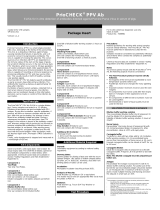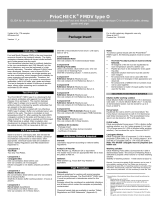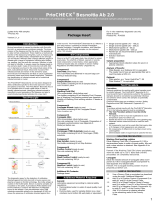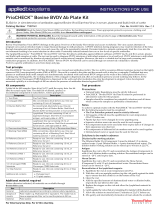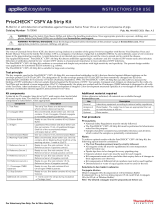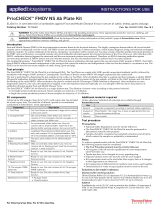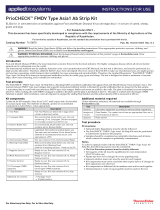Page is loading ...

PrioCHECK
®
BRSV Ab
ELISA for in vitro detection of antibodies directed against Bovine Respiratory Syncytial Virus in serum of cattle
2 plate kit for 22 samples
©Prionics AG
Version 1.0_e
For in-vitro veterinary diagnostic use only
Store at 5±3°C
Product No.: 7588991
Introduction
Bovine Respiratory Syncytial Virus (BRSV) belongs to
the genus Pneumovirus of the family Paramyxoviridae.
BRSV is closely related to Human-, Ovine- and Ca-
prine RSV. A primary BRSV infection can result in
severe lower respiratory tract disease in susceptible
cattle, but asymptomatic infections do occur as well. In
endemic areas, clinical disease is most apparent in
calves, and resembles the disease in infants infected
with HRSV. After a primary natural BRSV or HRSV
infection, the protection against re-infection is short-
lived and multiple re-infections are common. Primary
BRSV infections in individual animals can easily be
monitored by titration of sequential serum samples of
individual cows. A fourfold rise of antibody titer in two
successive sera can be considered as a seroconver-
sion (=primary infection) in that particular period.
The PrioCHECK
®
BRSV Ab is a modification of the
assay described by Westenbrink et al. When com-
pared with the virus neutralization test, the ELISA has
a relative sensitivity of approximately 90% and a
relative specificity of 100%.
Test Principle
The PrioCHECK
®
BRSV Ab is an indirect ELISA. A
microtitre strip Test Plate is coated with monoclonal
antibodies directed against BRSV and a non relevant
protein to block a-specific binding places. BRSV-
antigen is captured by these monoclonal antibodies.
Sera which have to be tested are diluted (1:80) and
dispensed in the wells containing the captured anti-
gen. Antibodies directed against BRSV which are
present in the test serum, will bind to the antigen
during incubation. The bound antibodies are detected
using an anti bovine polyclonal antibody conjugated to
the enzyme horse radish peroxidase (HRPO). Bound
conjugate is visualized by adding Chromogen (TMB)
Substrate. Finally, color development is stopped and
measured at a wavelength of 450 nm.
Kit Components
Store kit at 5±3°C until expiry date. See kit label for
actual expiry date. The shelf life of diluted, opened or
reconstituted components is noted below, where
appropriate.
Chemical hazard data are available in section “Safety
Regulations and R&S Statements” (Appendix II).
Component 1
Test Plate
Two strip Test Plates.
Component 2
Conjugate (30x)
(30x concentrated, dilute before use)
One vial contains 1.5 ml Conjugate.
Diluted conjugate is not stable, prepare just before
use.
Component 3
Dilution Buffer (5x)
(5x concentrated, dilute before use)
One vial contains 60 ml Dilution Buffer.
Shelf life of dilution buffer working solution: 5 hours at
22±3°C.
Component 4
Washing Fluid (200x)
(200x concentrated, dilute before use)
One vial contains 60 ml Washing Fluid.
Shelf life of washing solution: 1 week at 22±3°C.
Component 5
Demineralized Water
One vial contains 10 ml Demineralized Water.
Component 6
Horse Serum (lyophilized)
One vial contains 6.0 ml lyophilized Horse Serum.
Shelf life of reconstituted horse serum: until expiry
date at -20°C.
Component 7
Antigen (lyophilized)
Two vials, each contains 10 ml lyophilized Antigen.
Shelf life of reconstituted antigen: until expiry date at
-20°C.
Component 8
Reference Serum 1 (lyophilized)
One vial contains 0.25 ml Reference Serum 1 (positive
control serum).
Shelf life of reconstituted reference serum 1: until
expiry date at -20°C.
Component 9
Reference Serum 2 (lyophilized)
One vial contains 0.25 ml Reference Serum 2 (nega-
tive control serum).
Shelf life of reconstituted reference serum 2: until
expiry date at -20°C.
Component 10
Reference Serum 3 (lyophilized)
One vial contains 0.25 ml Reference Serum 3 (weak
positive control serum).
Shelf life of reconstituted reference serum 3: until
expiry date at -20°C.
Component 11
Chromogen (TMB) Substrate (Ready-to-use)
One vial contains 60 ml Chromogen (TMB) Substrate.
Component 12
Stop Solution (Ready-to-use)
One vial contains 60 ml Stop Solution.
Additional Kit Contents:
- Package Insert
- 1 lid to cover the strips during incubation
- Certificate of analysis
Additional Material Required
General:
Laboratory equipment according to national safety
regulations.
Incubation:
Microplate Incubator (reaching at least 50°C).
Analysis of Results:
Plate Reader e.g. Multiscan EX or equivalent.
The reader has to have an appropriate filter set to read
the plates at 450 nm.
Optional:
Plate washer e.g. Tecan EIA Tray Washer or
equivalent.
Test Procedure
Precautions
National guidelines for working with animal samples
must be strictly followed. The PrioCHECK
®
BRSV Ab
must be performed in laboratories suited for this
purpose.
Samples should be considered as potentially infectious
and all items which contact the samples as potentially
contaminated.
Chemical hazard data are available in section “Safety
Regulations and R&S Statements” (Appendix II).
Notes
To achieve optimal results with the PrioCHECK
®
BRSV Ab, the following aspects must be considered:
The Test Procedure protocol must be strictly
followed.
All reagents of the kit must be equilibrated to room
temperature (22±3°C) before use.
Pipette tips have to be changed for every pipetting
step.
Separate solution reservoirs must be used for each
reagent.
Kit components must not be used after their expiry
date or if changes in their appearance are ob-
served.
Kit components of different kit lot numbers must not
be used together.
Demineralized or water of equal quality must be
used for the test.
SOLUTIONS TO BE MADE IN ADVANCE
Dilution buffer working solution
The concentrated Dilution Buffer (5x) (Component 3)
must be diluted 1/5 in demineralized water.
Stability of dilution buffer working solution: 5 hours at
22±3°C.
Horse Serum
Reconstitute
1
the Horse Serum (Component 6) with 6
ml Demineralized Water (Component 5). Store recon-
stituted horse serum at -20°C and homogenize well
after thawing.
ELISA buffer
Add reconstituted horse serum to dilution buffer
working solution until a final concentration of 4%. Add
400 µl reconstituted horse serum to 9.6 ml dilution
buffer working solution.
ELISA buffer can be stored at 22±3°C for up to 4
hours.
Antigen
Reconstitute
1
the Antigen (Component 7) with 10 ml
ELISA buffer. For partial use of the test kit the recon-
stituted antigen should be divided in 1.6 ml aliquots
(for a maximum of 6 test runs per plate). Avoid multiple
freezing and thawing and store the aliquots in small
vials at -20°C.
Conjugate dilution
Dilute the Conjugate (30x) 1/30 in ELISA buffer.
Prepare 1.8 ml to perform a test with two strips.
Note: The conjugate dilution must be prepared just
before use.
Reference sera
Reconstitute
1
each of the Reference Sera (Component
8, 9 and 10) with 250 µl Demineralized Water (Com-
ponent 5). After reconstitution of the Reference Sera, it
is recommended to prepare aliquots of 20 µl. Avoid
multiple freezing and thawing and store the aliquots in
small vials at -20°C.
Washing solution
1 Reconstitution of lyophilized reagents should be performed as follows:
- Equilibrate the vials to 22±3°C.
- With the vial in an upright position, tap the vial gently against the
worktop to ensure that the content is on the bottom of the vial.
- Open the vial.
- Add the required amount of Demineralized Water or buffer
- Allow the lyophilized material to dissolve.
- Replace the stopper on the vial and gently rotate the vial so that any
remaining dry material will be dissolved.
- Allow the lyophilized material to stand for 15 minutes at 22±3°C.
- Occasionally gently invert the vial (formation of foam should be
avoided).
Package Insert

PrioCHECK
®
BRSV Ab
The Washing Fluid (200x) (Component 4) must be
diluted 1/200 in demineralized water and is sufficient
for a final volume of 12 liters of washing solution.
Stability of washing solution: 1 week at 22±3°C.
Note: Commercially available ELISA washers can be
used. If not available, washing of the plates can be
done by hand by dispensing 200 - 300 µl of washing
solution to all wells of the plate. Subsequently, empty
the plate and repeat as many times as prescribed. It is
not necessary to soak the plate. Tap the plate firmly
after the last washing.
PREPARATION OF SERUM DILUTIONS
1.1 Make a 1:80 dilution of the reference sera 1, 2
and 3 and of the test sera by mixing 10 µl of se-
rum with 790 µl ELISA buffer.
INCUBATION OF ANTIGEN
2.1 Label each strip of the Test Plate (Component 1)
with a marker pen. (One Test Plate is needed for
11 titrated samples).
2.2 Dispense 100 µl of ELISA buffer to the wells of
row A, except in well A1. The wells of row A are
serum control wells.
2.3 Dispense 100 µl of antigen in the remaining
wells.
2.4 Cover the Test Plate with the incubation lid and
incubate for 60±5 minutes at 37±1°C.
INCUBATION OF TEST SERUM
3.1 Empty the Test Plate and wash the wells 6 times
with 200 to 300 µl washing solution. Soaking the
wells with washing solution is not needed. Tap
the plate firmly after the last washing cycle.
3.2 Dispense 100 µl of ELISA buffer to wells A1 and
B1 (=blanks).
3.3 Dispense 100 µl of reference serum 1, diluted
1:80, to wells C1 and D1.
3.4 Dispense 100 µl of reference serum 2, diluted
1:80, to wells E1 and F1.
3.5 Dispense 100 µl of reference serum 3 (= weak
positive control serum), diluted 1:80, to wells G1
and H1.
3.6 Dispense 100 µl of ELISA buffer to wells C2 to
H12.
3.7 Dispense 100 µl test serum, diluted 1:80, to well
A2 and B2. Then make twofold serial dilutions of
the test serum:
Well C2: 1:160 = 100 µl 1:80 + 100 µl ELISA
buffer.
Well D2: 1:320 = 100 µl 1:160 + 100 µl ELISA
buffer.
Well E2: 1:640 = 100 µl 1:320 + 100 µl ELISA
buffer.
Repeat up to well H2. Final dilution is 1:5120
Remove 100 µl from well H2
3.7 Dispense 100 µl test sera, diluted 1:80, in the
remaining wells of row A, B and C of the Test
Plate and make titrations in the same way as the
first test serum.
3.8 Incubate for 60±5 minutes at 37±1°C.
INCUBATION WITH CONJUGATE
4.1 Empty the Test Plate and wash the wells 6 times
with 200 to 300 µl washing solution. Soaking the
wells with washing solution is not needed. Tap
the plate firmly after the last washing cycle.
4.2 Dispense 100 µl of the diluted conjugate to all
wells.
4.3 Seal the Test Plate and incubate for 45±2 min-
utes at 37±1°C.
INCUBATION WITH CHROMOGEN (TMB) SUB-
STRATE
5.1 Empty the Test Plate and wash the wells 6 times
with 200 to 300 µl washing solution. Soaking the
wells with washing solution is not needed. Tap
the plate firmly after the last washing cycle.
5.2 Dispense 100 µl of Chromogen (TMB) Substrate
(Component 11) to all wells.
5.3 Incubate the plate for 15 minutes at 22±3°C.
5.4 Add 100 µl of Stop Solution (Component 12) to
all wells.
5.5 Mix the content of the wells of the plate.
Note: Start the addition of Stop Solution 15 minutes
after the first well was filled with Chromogen (TMB)
Substrate. Add the Stop Solution in the same order
and the same pace as the Chromogen (TMB) Sub-
strate was dispensed.
READING OF THE TEST AND CALCULATING THE
RESULTS
6.1 Measure the optical density (OD) of the wells at
450 nm within 15 minutes after color develop-
ment has been stopped.
6.2 Calculate the average OD
450
value of the two
blank controls (wells A1 and B1). Calculate the
corrected OD
450
of each serum sample (or serum
dilution) by subtracting the average OD
450
of the
blank controls. Calculate the average OD
450
of
the duplicate control sera.
6.3 The corrected OD
450
values of the sera are
expressed as percentage positivity (PP) of the
mean corrected OD value of 1:80 dilution of ref-
erence serum 1 (well C1 and D1).
corrected OD
450
test sample
PP = ------------------------------------------------- x 100
corrected OD
450
reference serum 1
RESULT INTERPRETATION
Validation criteria
7.1 The mean OD
450
of the blank control (wells A1
and B1) should be <0.300.
7.2 The corrected OD
450
of Reference Serum 1, 1:80
diluted (well C1 and D1) must be ≥1.000.
7.3 The mean PP of Reference Serum 3 must score
positive.
7.4 The mean PP of Reference Serum 2 must score
negative.
7.5 Test sera which have a positive reaction in the
serum control well (row A) must be critically
evaluated as follows. A test serum reacts
aspecific in the BRSV Ab ELISA when the PP of
the control well is >30% and the PP of the test
sample, diluted 1:80, is < 2x PP of the corre-
sponding control well.
7.6 Not meeting any of these criteria is reason to
discard the results of that specific test plate.
Note: If the corrected OD
450
of Reference Serum 1 is
below 1.000 possibly the Chromogen (TMB) Substrate
is too cold. In that case warm the solution to 22±3°C or
incubate up to 30 minutes.
If the corrected OD
450
of Reference Serum 1 is above
2.000 a shorter incubation period with the Chromogen
(TMB) Substrate is recommended.
Interpretation of the percentage positivity
PP = <15%
Test sample is negative for BRSV specific antibodies.
PP = ≥15%
Test sample is positive for BRSV specific antibodies.
Appendix I
Notice
This manual is believed to be complete and accurate at the time
of publication. In no event shall Prionics AG be liable for
incidental or consequential damage in connection with or
arising from the use of this manual.
Liability
Prionics AG warrants its products will meet their applicable
published specification when used in accordance with their
applicable instructions and within the declared products life
time. Prionics AG makes no other warranty, expressed or
implied. There is no warranty of merchantability or fitness for a
particular purpose. The warranty provided herein and the data,
specifications and descriptions of Prionics AG products appear-
ing in Prionics AG published catalogues and product literature
may not be altered except by express written agreement signed
by an officer of Prionics AG. Representation, oral or written,
which are inconsistent with this warranty or such publications
are not authorized and if given, should not be relied upon.
In the event of a breach of the foregoing warranty, Prionics
AG’s sole obligation shall be to repair or replace, at its option,
the applicable product or part thereof, provided the customer
notifies Prionics AG promptly of any such breach. If after
exercising reasonable efforts, Prionics AG is unable to repair or
replace the product or part, then Prionics AG shall refund to the
customer all monies paid for such applicable product or part.
Prionics AG shall not be liable for consequential, incidental,
special or any other indirect damages resulting from economic
loss or property damage sustained by any customer from the
use of its products.
Prionics AG and Prionics Lelystad B.V. are ISO 9001:2000
certified companies.
Appendix II
Safety Regulations and R&S Statements
National Safety Regulations must be strictly followed.
Component 1
Test Plate
Hazard Code: This product is not classified according to EU
regulations.
Component 2
Conjugate (30x)
Hazard Code: This product is not classified according to EU
regulations.
Component 3
Dilution Buffer (5x)
Hazard Code: This product is not classified according to EU
regulations.
Component 4
Washing Fluid (200x)
Hazard Code: This product is not classified according to EU
regulations.
Component 5
Demineralized Water
Hazard Code: This product is not classified according to EU
regulations.
Component 6
Horse serum (lyophilized)
Hazard Code: This product is not classified according to EU
regulations.
Component 7
Antigen (lyophilized)
Hazard Code: This product is not classified according to EU
regulations.
Component 8
Reference Serum 1 (lyophilized)
Hazard Code: This product is not classified according to EU
regulations.
Component 9
Reference Serum 2 (lyophilized)
Hazard Code: This product is not classified according to EU
regulations.
Component 10
Reference Serum 3 (lyophilized)
Hazard Code: This product is not classified according to EU
regulations.
Component 11
Chromogen (TMB) Substrate (Ready-to-use)
Hazard Code: This product is not classified according to EU
regulations.
Component 12
Stop Solution (Ready-to-use)
Hazard Code: R35: Causes severe burns.
S26: In case of contact with eyes, rinse immediately with plenty
of water and seek medical advice.
S36/37/39: Wear suitable protective clothing, gloves and
eye/face protection.
S45: In case of accident or if you feel unwell, seek medical
advice immediately (show the label on vial).
Appendix III
References
(1) Paccaud MF and Jacquier Cl.
Arch. für die gesamte Virusforschung. 30, 327-342, 1970.
(2) Collins PL. Plenum Press, New York, p. 103-162.
(3) Westenbrink F, Brinkhof JMA, Straver PJ, Quak J and de
Leeuw PW.
Research in Vet. Sci. 38, 334-340, 1985.
(4) Martin SW, Shoukri M and Thorburn MA.
Preventive Vet. Med. 14, 33-43, 1992.
(5) Van der Poel WHM, Kramps JA, Middel WGJ, Van
Oirschot JT and Brand A.
Arch. Virol. 133, 309-321, 1993.
(6) Schrijver RS.
Thesis 1997 (ISBN 90-393-1499-3).
(7) Van der Poel WHM.
J. of Infection. 29, 215-228, 1994.
Contact
For our distribution network, please refer to www.prionics.com
/
